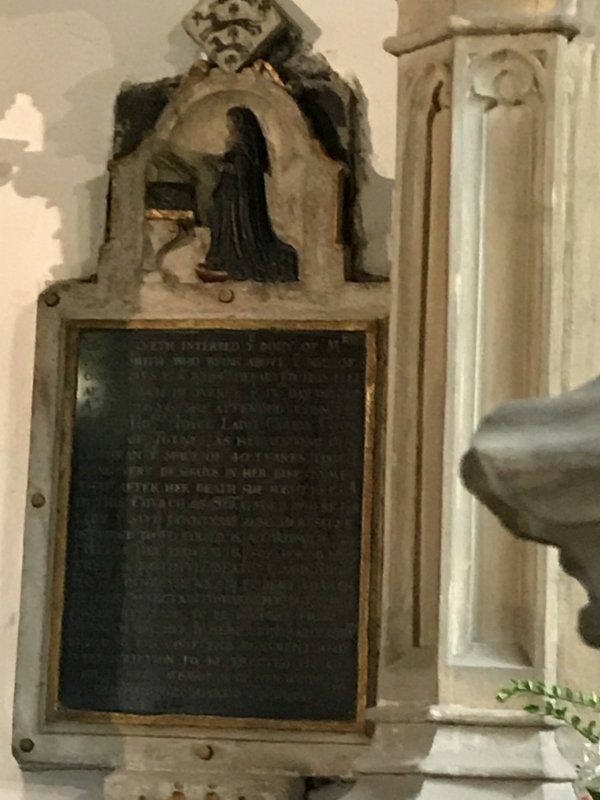
We know almost nothing of the millions of people listed in the nation’s parish registers: unless known to us already, they are names only. This would have been the case for Amy Smith, who features in the burial register of Holy Trinity Church, Stratford-upon-Avon, were it not for a memorial plaque for her in the church. As will be seen the dates of death and funeral seem improbable, although not impossible.
On 17 September 1626 the funeral of ‘Mris Amis Smith’ was entered into the burial register. Amy was buried in the church under the direction of her long-term employer Joyce, Countess of Totnes; it was Joyce who had the memorial placed in the Clopton Chapel: a rectangular panel enclosing the image of a woman, dressed in a black gown and white ruff kneeling at a prie dieu (kneeling bench), with a tribute to the late Amy:
‘Heere lyeth interred ye Body of Mris. / Amy Smith, who being about ye age of / 60 yeares and a maide departed this life / at Nonsuch in Surrey / ye 13th day of Sep. / Ao Dni. 1626. She attended upon the / Right Hnble. Joyce Ladie Carew, Coun / tesse of Totness, as her waiting gen / tlewoman ye space of 40 yeares together, / being very desirous in her life tyme / that after her death she might be laide / in this church of Stratford where her / Lady ye said Countesse also her selfe / intended to be buried and accordinglie to / fullfill her request and for her so long / trew & faithfull servis ye said Right / Hoble. Countess as an evident oaken / of her affection towards her not onely / caused her body to be brought from Nonsuch heither & here honorably buried . But also did cause this monument and / superscription to be erected in a / grateful memorie of her whom / she had foun so good a servant.’
A fulsome epitaph indeed. Few servants can have been memorialised in such a way, fewer still transported over a hundred miles for burial. But what is telling about this plaque is that it is of common freestone, indicating that however loyal and efficient Amy had been, her status did not warrant marble or alabaster.
Joyce was the daughter of William Clopton of Clopton House, one mile north of Stratford-upon-Avon. She married George Carew in 1580 at the Holy Trinity Church. George was a twenty-five-year-old soldier statesman, later the earl of Totnes, a member of the courts of Elizabeth I and James I. As well as inheriting Clopton House, the couple had a house in the Savoy in London and, as is shown in Amy’s epitaph, also used Nonsuch Palace in Surrey (Henry VIII’s prestigious palace, which by the Carews’ time was falling into disrepair).
Amy joined the Carew household in about 1585. It is not known from where she came, but it may have been Stratford, and Amy may have hailed from the gentry. The historian Antonia Fraser suggests that, at that time, the only ‘respectable profession’ for an unmarried woman of good breeding and education ‘was that of “gentlewoman” or waiting-woman to another prosperous female’. Fraser describes the position of a gentlewoman of the time: ‘ a companion, confidante or what would now be termed a personal secretary to a great lady, enjoy[ing] a powerful and protected position which had little of the menial about it.’ So, we can be assured Amy was not a general servant, and quite possibly she had received an education.
Amy Smith never married and was obviously very attached to her mistress Joyce; the attachment was mutual, which is clear from the above inscription. The loss of such a faithful servant – more likely a great friend after forty years – must have been devastating to Joyce. George Carew died in London in March 1629 and was buried in Holy Trinity Church a month later. The widowed Joyce was buried with her husband on 28 January 1636/7. The couple are memorialised by the very grand monumental tomb in the Clopton Chapel, beside which is Amy Smith’s memorial plaque.

